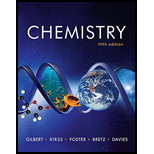
Concept explainers
Interpretation: The concentration of different ions that are present in river water is given. The molality of these six different ions is to be calculated.
Concept introduction: Molality is defined as the number of moles of solute that is present in
To determine: The molality of given six different ions that are present in the river water.
Answer to Problem 11.68QP
Solution
The concentration of
The concentration of
The concentration of
The concentration of
The concentration of
The concentration of
Explanation of Solution
Explanation
Given
The concentration of
The concentration of
The concentration of
The concentration of
The concentration of
The concentration of
The mass of solvent is
The conversion of
Hence, the conversion of
Similarly, the conversion of
Similarly, the conversion of
Similarly, the conversion of
Similarly, the conversion of
Similarly, the conversion of
The molar mass of Aluminum is
The molar mass of Iron is
The molar mass of Calcium is
The molar mass of Sodium is
The molar mass of Potassium is
The molar mass of Magnesium is
The number of moles of a substance is calculated as,
Substitute the value of given mass and molar mass of
Similarly, substitute the value of given mass and molar mass of
Similarly, substitute the value of given mass and molar mass of
Similarly, substitute the value of given mass and molar mass of
Similarly, substitute the value of given mass and molar mass of
Similarly, substitute the value of given mass and molar mass of
The molality of the solution is calculated as,
Substitute the number of moles of
The concentration of
Similarly, substitute the number of moles of
The concentration of
Similarly, substitute the number of moles of
The concentration of
Similarly, substitute the number of moles of
The concentration of
Similarly, substitute the number of moles of
The concentration of
Similarly, substitute the number of moles of
The concentration of
Conclusion
The concentration of
The concentration of
The concentration of
The concentration of
The concentration of
The concentration of
Want to see more full solutions like this?
Chapter 11 Solutions
Chemistry: The Science in Context (Fifth Edition)
- what is the skeletal structure of a tertiary alkyl fluoride with six carbon atoms and no rings.arrow_forwardOne step of glycolysis is a retro-aldol reaction (aldolase) to produce ATP.Below is the aldol reaction of the equilibrium. Show the mechanism for the base catalyzed reaction. *see imagearrow_forwardProvide the missing information. *see imagearrow_forward
- Provide the missing information. *see imagearrow_forwardProvide the missing information. *see imagearrow_forwardDraw the mechanism (including all curved arrows for electron movement) showing how the maleicanhydride is attacked by the anthracene and formation of the final Diels Alder product.arrow_forward
 ChemistryChemistryISBN:9781305957404Author:Steven S. Zumdahl, Susan A. Zumdahl, Donald J. DeCostePublisher:Cengage Learning
ChemistryChemistryISBN:9781305957404Author:Steven S. Zumdahl, Susan A. Zumdahl, Donald J. DeCostePublisher:Cengage Learning ChemistryChemistryISBN:9781259911156Author:Raymond Chang Dr., Jason Overby ProfessorPublisher:McGraw-Hill Education
ChemistryChemistryISBN:9781259911156Author:Raymond Chang Dr., Jason Overby ProfessorPublisher:McGraw-Hill Education Principles of Instrumental AnalysisChemistryISBN:9781305577213Author:Douglas A. Skoog, F. James Holler, Stanley R. CrouchPublisher:Cengage Learning
Principles of Instrumental AnalysisChemistryISBN:9781305577213Author:Douglas A. Skoog, F. James Holler, Stanley R. CrouchPublisher:Cengage Learning Organic ChemistryChemistryISBN:9780078021558Author:Janice Gorzynski Smith Dr.Publisher:McGraw-Hill Education
Organic ChemistryChemistryISBN:9780078021558Author:Janice Gorzynski Smith Dr.Publisher:McGraw-Hill Education Chemistry: Principles and ReactionsChemistryISBN:9781305079373Author:William L. Masterton, Cecile N. HurleyPublisher:Cengage Learning
Chemistry: Principles and ReactionsChemistryISBN:9781305079373Author:William L. Masterton, Cecile N. HurleyPublisher:Cengage Learning Elementary Principles of Chemical Processes, Bind...ChemistryISBN:9781118431221Author:Richard M. Felder, Ronald W. Rousseau, Lisa G. BullardPublisher:WILEY
Elementary Principles of Chemical Processes, Bind...ChemistryISBN:9781118431221Author:Richard M. Felder, Ronald W. Rousseau, Lisa G. BullardPublisher:WILEY





